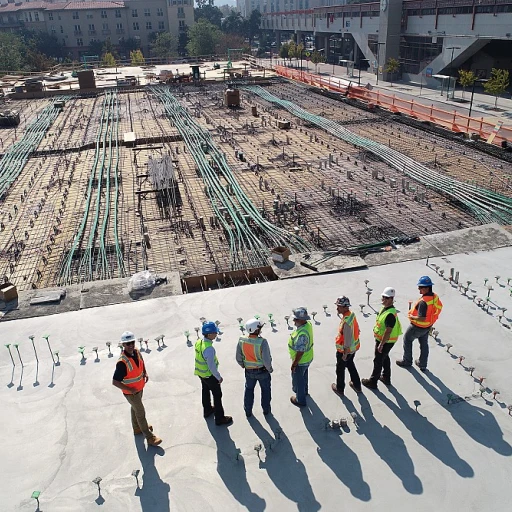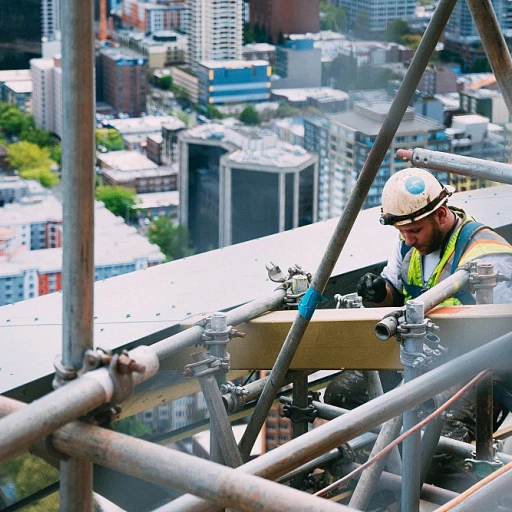The Integral Role of HR in Facilitating Performance Reviews
Let's start by shedding light on the pivotal role that Human Resources (HR) plays in the successful conduct of performance reviews. Acting as the glue that binds various elements of the performance review process, HR professionals are tasked with ensuring that reviews are not only productive but also equitable and conducive to the overall growth of employees and the organization alike.
From setting the groundwork by collaborating with managers to establish clear performance metrics and objectives, HR ensures that everyone is aligned on what constitutes success. This foundation is vital as it feeds into the other stages of the performance review process, such as setting clear goals and expectations – something we'll explore in more detail in a later part of the article.
Moreover, HR holds the responsibility of upholding fairness and transparency during the performance evaluations. By facilitating training sessions for managers on how to conduct unbiased reviews and effectively provide feedback, HR professionals contribute significantly to maintaining a culture of trust and growth within the company. Feedback, when conveyed properly, can be a powerful tool for motivation and professional development, as we will discuss further.
Human Resources also serves as a mediator to ensure that the communication between managers and employees during the reviews is constructive and aimed at employee engagement. More on engaging employees through effective communication will be touched upon in future sections of this series.
In essence, the HR department's intervention in performance reviews is indispensable for fostering an environment of continuous improvement and setting the stage for productive follow-ups, two aspects we will delve deeper into as we progress.
Setting Clear Goals and Expectations
Establishing Transparent Communication Channels
In any HR-driven performance review, establishing transparent communication channels is crucial for success. When HR professionals set clear goals and expectations, they effectively eliminate ambiguity and promote a culture of honesty and transparency within the organization. This not only helps employees understand their individual objectives but also allows them to align their efforts with the company's strategic vision.
Effective HR communication involves articulating expectations to employees in a way that resonates with them. Clear communication means defining what success looks like and ensuring these parameters are measurable. For instance, when a salesperson is tasked with achieving a specific sales target, it's essential that they understand what tools and resources are available to help them reach their goal. By keeping these lines of communication open, HR can foster a supportive environment where employees feel motivated to reach their potential.
By proactively engaging in regular conversations throughout the performance cycle, HR can ensure that both employees and managers remain on the same page. This proactive approach allows for adjustments and realignments throughout the review period to accommodate any changes in business priorities or individual capabilities. When employees know what is expected of them, they can focus their efforts on meeting those objectives.
In addition, clear goal-setting isn't just a one-time conversation. It requires an ongoing dialogue that reinforces expectations and adapts to any shifts in the organizational landscape. This aligns with categories like "continuous improvement" and ensuring that employees see the performance review as a constructive, developmental process rather than a mere appraisal. Leveraging tools and strategies for this ongoing dialogue creates a more dynamic and responsive review process, benefitting both the individual and the organization as a whole.
Providing Constructive Feedback
The Power of Clarity in Feedback
Providing feedback is an essential component of performance reviews, yet it needs to go beyond mere evaluation. It is a forward-thinking approach that aims to guide employees towards personal and professional growth. HR professionals play a vital role here, ensuring that feedback is not only constructive but also clear, relevant, and actionable.
One way to achieve this is by aligning feedback with the distinct goals and expectations set for the employee, as addressed earlier. When feedback is directly connected to these predefined goals, it ensures transparency and relevance, preventing miscommunication and misunderstandings.
Balanced Feedback: The Strengths and Opportunities
While it is crucial to address areas of improvement, highlighting an employee’s strengths is equally important. A balanced approach that acknowledges achievements fosters a positive atmosphere and boosts morale. This positivity paves the way for constructive conversations focused on future improvement rather than dwelling on past inadequacies.
HR leaders should aim for a mix of specific, actionable insights, underlining what employees are doing well, and gently pointing out areas for development. Such an approach can drive motivation and engagement, as discussed in our article on enhancing employee onboarding.
Empathy and Active Listening
Empathy in communication can significantly impact how feedback is received and processed. By actively listening to employee concerns and fostering openness, HR can create a safe space for honest dialogue. This empathy-driven approach not only makes feedback more palatable but also strengthens the overall relationship between management and employees.
Ultimately, the art of providing constructive feedback is a dynamic process; it evolves with each interaction and requires consistent attention to detail, empathy, and clarity in communication. By mastering these elements, HR can facilitate a performance review system that genuinely supports employee growth and organizational success.
Engaging Employees Through Effective Communication
Fostering a Dialogue for Better Engagement
Effective communication is the cornerstone of employee engagement during performance reviews. By establishing a two-way conversation, HR professionals can create an environment where employees feel valued and heard. This approach not only helps in apprehending employee concerns but also empowers them to take an active role in their professional development.
To enhance engagement, it's essential to maintain transparency throughout the performance review process. As discussed earlier, setting clear goals and expectations lays the groundwork for meaningful discussions. Communicating these objectives ensures employees understand what's being assessed and drives them towards achieving those targets.
Listening actively to employees' feedback and opinions can also significantly boost their engagement levels. Constructive feedback thrives on a foundation of mutual respect, and by valuing input from team members, HR professionals foster a sense of partnership. This collaborative approach encourages employees to voice their thoughts openly, leading to a more productive and positive performance review experience.
Incorporating digital tools, such as performance review software, can also play a pivotal role in enhancing communication. These platforms facilitate conversations by providing a structured and transparent way to document and track employee performance. As a result, HR professionals and employees can easily review past performance, making it easier to address concerns and celebrate achievements.
Finally, remember that performance reviews should not be a one-time event. Engaging employees through continuous improvement and follow-up demonstrates your commitment to their growth. Regular check-ins and feedback sessions ensure that communication remains open, encouraging employees to stay engaged and motivated throughout their journey.
Leveraging Advanced Tools to Streamline the Review Process
In today's rapidly evolving business landscape, utilizing performance review software has become indispensable for human resources professionals tasked with navigating performance evaluations efficiently. By integrating these sophisticated tools, companies can streamline the review process and ensure consistency across departments and teams.
Performance review software offers various features designed to enhance transparency and simplify data management. These platforms often include customizable templates, real-time progress tracking, and secure document storage options. As a result, managers and employees can easily access past reviews, track individual progress, and establish a clear history of performance data.
Moreover, the ability to automate repetitive tasks, such as deadline reminders and performance metrics updates, allows HR professionals to dedicate more time to meaningful interactions with employees. This aligns well with engaging employees through effective communication, as highlighted earlier. With less administrative burden, HR teams can focus on providing personalized support and development opportunities.
Implementing these tools not only increases efficiency but also enhances the accuracy of performance assessments. Software solutions provide advanced analytics and reporting capabilities, offering deeper insights into individual and team performance. This data-driven approach enables HR professionals to make informed decisions, facilitating the continuous improvement and follow-up necessary for employee growth.
Ultimately, embracing technology in performance reviews can significantly improve the overall process, fostering a culture of accountability and engagement within the organization. As businesses continue to adapt to new challenges, these digital solutions will play a vital role in supporting both HR practitioners and employees in achieving their goals.
Continuous Improvement and Follow-Up
The Importance of Self-Reflection and Adaptation
Performance reviews aren't just about assessing past performance; they are also a valuable opportunity for growth and development, both for employees and the organization. A continuous improvement approach ensures that performance reviews are not viewed as a single event, but rather an ongoing process integral to the company culture.
Self-reflection is a key component in promoting continuous improvement. Encourage employees to assess their own progress, skills, and areas for improvement regularly. This practice not only empowers them by fostering a sense of responsibility for their development but also provides valuable insights that can be used during performance review discussions.
To make self-reflection effective, create an environment where giving and receiving feedback is natural. A culture of open communication, as previously emphasized, helps in creating a trusted space where employees feel safe to express their opinions and feedback can be more candidly exchanged.
Actively Following Up
The performance review process should not end with a discussion. Actively following up on the goals and feedback discussed in reviews is crucial for fostering an ongoing improvement cycle. Schedule regular check-ins to review progress on the goals set during the performance reviews. This approach helps keep everyone accountable and ensures that steps are being taken towards achieving these goals.
In these check-ins, provide opportunities to refine goals if necessary, adapting to any changes in the business environment or employee circumstances. Keep in mind that employee engagement is strengthened when they see that their development is taken seriously and when there's a genuine interest in their growth.
Learning from Feedback to Refine Processes
Feedback collected during the performance review and continuous follow-up process is a treasure trove for HR teams. Use this feedback to refine your processes and improve future performance reviews. Analyze what's working well and identify areas that need enhancement. This iterative approach to refining HR processes echoes the strategic setting of clear goals and expectations previously discussed.
Remember, continuous improvement isn't limited to employee performance; it extends to all organizational processes. By leveraging feedback, HR departments can enhance their approaches, leading to more effective reviews in the future.
By fostering a culture of continuous improvement within performance reviews, HR departments can not only boost employee development but also drive the organization towards achieving its strategic objectives more effectively. This cycle of reflection, adaptation, and follow-up strengthens the overall performance management system, paving the way for sustained success.




